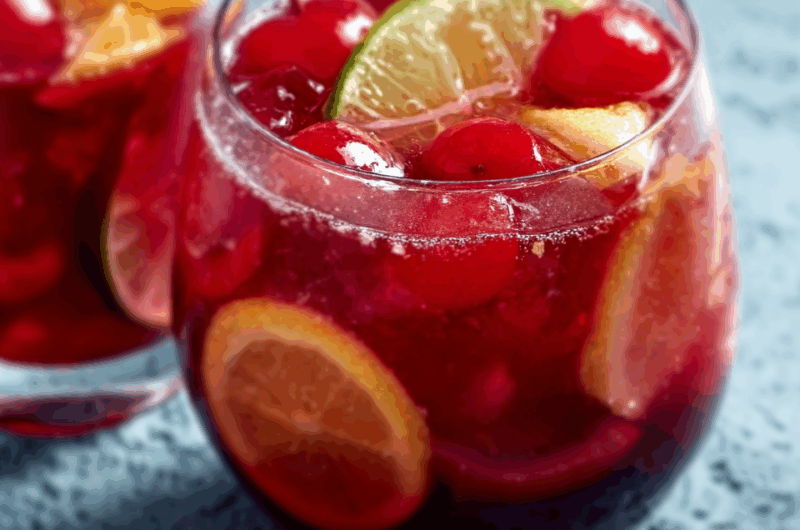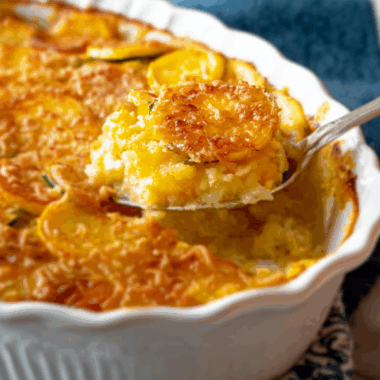Sangria Sangria is a classic Spanish-inspired beverage that perfectly balances the richness of red wine with the brightness of citrus and fresh berries. Infused with brandy and orange liqueur, this refreshing drink is sweet, tangy, and ideal for serving chilled on a warm day.
What makes this drink so versatile is how easily you can customize it. Add seasonal fruits like peaches, apples, or even tropical pineapple for a twist. Swap soda water for lemon-lime soda if you like a sweeter fizz. Whether served at backyard parties, picnics, or holiday gatherings, this sangria is a surefire way to bring a festive, colorful touch to your table.
Full Recipe:
-
1 bottle dry red wine (750 ml)
-
1/4 cup brandy
-
1/4 cup orange-flavored liqueur (such as Triple Sec)
-
1/4 cup white sugar
-
1 orange, sliced into rounds
-
1 lemon, sliced into rounds
-
1 lime, sliced into rounds
-
1/2 cup strawberries, sliced
-
1/2 cup pineapple chunks (optional)
-
1/2 cup soda water or lemon-lime soda (for topping before serving)
-
Ice cubes, as needed
Directions:
-
In a large pitcher, combine the red wine, brandy, orange liqueur, and sugar. Stir until the sugar dissolves.
-
Add the sliced orange, lemon, lime, and strawberries. Stir gently to combine.
-
Refrigerate for at least 2–4 hours (or overnight) to allow flavors to meld.
-
Just before serving, add the pineapple chunks (if using) and soda water for a sparkling touch.
-
Serve chilled over ice, making sure each glass has a bit of fruit for garnish.
Prep Time: 10 minutes | Chill Time: 2–4 hours | Total Time: 2 hours 10 minutes
Kcal: ~200 kcal per serving | Servings: 6–8 glasses
The Allure of Sangria Sangria
Sangria Sangria is more than just a refreshing drink—it’s a cultural experience in a glass. Known for its vibrant blend of red wine, citrus fruits, and a splash of liqueur, this beverage has long been associated with Spain’s festive lifestyle. Its origins reach back centuries, but today it has become a symbol of summer gatherings, parties, and celebrations worldwide. The drink stands out because it’s not only delicious but also social by nature—made to be shared from a large pitcher, encouraging conversation and enjoyment.
A Brief History of Sangria
The roots of sangria trace back to the Iberian Peninsula, where wine and fruit have been staples of daily life for thousands of years. The word “sangria” itself comes from the Spanish word “sangre,” meaning blood—a reference to its rich, deep red color. While ancient Romans were known to mix wine with fruits and spices as a way to improve flavor and ensure safe drinking, modern sangria became popular in Spain during the Middle Ages. It was a way to use abundant citrus and fruits while creating a refreshing, lightly sweetened beverage.
By the mid-20th century, sangria made its way across the Atlantic and was officially introduced to American audiences at the 1964 World’s Fair in New York. Since then, it has gained international fame, becoming a favorite at restaurants, outdoor events, and home gatherings.
Why Sangria is So Popular
Sangria Sangria is celebrated for its versatility. Unlike many cocktails with rigid formulas, sangria welcomes creativity. It can be adjusted to suit the season, your favorite fruits, or the occasion. Whether you prefer it light and bubbly with soda water or richer with brandy and berries, it can be adapted without losing its essence.
The combination of wine and fruit also creates a layered taste profile—sweet, tangy, and slightly robust—making it appealing to a wide audience. Its vibrant colors also add to its charm, making it as visually delightful as it is flavorful.
Sangria as a Social Drink
Part of sangria’s enduring popularity lies in how it is served. Traditionally made in large pitchers or bowls, sangria is designed for sharing. It embodies the communal spirit of Spanish culture, where meals and drinks are rarely enjoyed alone. Sangria’s easy-drinking nature makes it perfect for social settings, whether that’s a summer barbecue, a festive holiday gathering, or a casual evening with friends.
Its ability to bring people together is one reason why it has become such a global favorite. Unlike complicated cocktails that require precise measurements and specialized tools, sangria is approachable and inviting for anyone to prepare.
Variations Across the Globe
Though traditionally made with red wine, brandy, citrus, and soda, sangria has evolved into countless variations. In Spain, you might encounter sangria de cava, made with sparkling white wine instead of red. In Portugal, a white wine version called sangria blanca is equally beloved. Across Latin America and the United States, people have added their own twists by incorporating tropical fruits like mango, pineapple, or passion fruit.
Seasonal adjustments are also common. In summer, lighter fruits and a splash of soda make the drink more refreshing, while in autumn, apples, pears, and cinnamon give sangria a cozy twist. This adaptability ensures that sangria never feels repetitive—it can be reinvented endlessly.
Pairing Sangria with Food
Sangria Sangria pairs beautifully with a wide range of dishes, which is another reason for its popularity at gatherings. Its fruity, slightly sweet notes complement spicy and savory foods perfectly. Spanish tapas, such as chorizo, patatas bravas, and Manchego cheese, are classic pairings. The acidity of the citrus helps cut through the richness of fried or fatty dishes, while the sweetness balances out salty or spicy flavors.
It also works wonderfully with grilled meats, seafood paella, and even lighter fare such as salads and charcuterie boards. For dessert, sangria complements fruit-based sweets, tarts, and creamy custards without overwhelming the palate.
Tips for Perfect Sangria
While the exact recipe can be adjusted, a few principles help ensure the best sangria experience. Choosing a good base wine is important, but it doesn’t need to be expensive. Medium-bodied, dry red wines work well because the fruit and liqueur add sweetness. Fresh fruit is another key element—citrus for brightness, berries for depth, and optional tropical fruits for flair.
Allowing the sangria to chill for a few hours before serving is also essential, as this gives the flavors time to meld. Finally, adding soda or sparkling water just before serving ensures a lively fizz that elevates the drink without watering it down prematurely.
Sangria Through the Seasons
Another reason sangria remains timeless is its adaptability to different seasons. In summer, it shines with citrus, strawberries, and light soda water, making it a cooling refreshment on hot days. In winter, it can be made richer with spices like cinnamon, cloves, or star anise, offering a warming effect similar to mulled wine but lighter and fruitier.
Spring versions might feature peaches, apricots, or fresh herbs like mint, while autumn recipes lean into apples, pears, and figs. This seasonal adaptability means sangria always feels fresh and appropriate for any time of year.
Cultural Significance
In Spain and beyond, sangria represents more than just a drink—it reflects the joy of slowing down, savoring food and drink, and spending time with loved ones. It has become part of Spanish tourism, often featured on restaurant menus alongside tapas, showcasing a relaxed lifestyle that appeals to visitors. At festivals, parties, and even weddings, sangria symbolizes celebration and togetherness.
Its global popularity also speaks to how cultures embrace and adapt culinary traditions. While the essence of sangria remains tied to Spain, the way it is enjoyed worldwide shows how food and drink can transcend borders, uniting people with shared flavors.
The Aesthetic of Sangria
Beyond taste, sangria is a feast for the eyes. The deep crimson hue of the wine, contrasted with bright slices of oranges, lemons, and strawberries, creates a visual spectacle. When served in a clear pitcher filled with ice, it becomes both a beverage and a centerpiece. This makes it especially popular for entertaining—it looks as good on the table as it tastes in the glass.
Conclusion: Why Sangria Sangria Belongs on Every Table
Sangria Sangria is more than just a refreshing cocktail; it’s a cultural tradition, a versatile recipe, and a centerpiece for gatherings. From its historical roots in Spain to its global popularity today, it remains beloved because it embodies the essence of hospitality and celebration. Its adaptability means it can suit any season, any occasion, and any personal preference.
For a summer barbecue, it provides cool relief. For a cozy autumn dinner, it delivers warmth and spice. For festive gatherings, it brings color, vibrancy, and a sense of joy. Sangria Sangria is more than a drink—it’s an experience, a story, and a reminder of how simple ingredients can create something extraordinary when shared with others.








